Gordon Ramsay, a chef known for his exacting standards and fiery pronouncements, once declared Moroccan cuisine the best on the planet. A bold claim, indeed! But is he right? Could the intricate spices, slow-cooked wonders, and ancient techniques truly elevate it above all others? There’s only one way to find out: taste it ourselves. Join us on a culinary pilgrimage to the heart of Morocco, the ancient city of Fez, as we explore the best Moroccan food and delve deep into the flavors that captivated one of the world’s most famous chefs. This isn’t just about eating; it’s about understanding the soul of Moroccan cuisine right where its history runs deepest. Prepare your senses as we navigate the bustling medina and uncover what to eat in Fez, experiencing Moroccan Cuisine Fez style.
Welcome to Fez: A Culinary Time Capsule
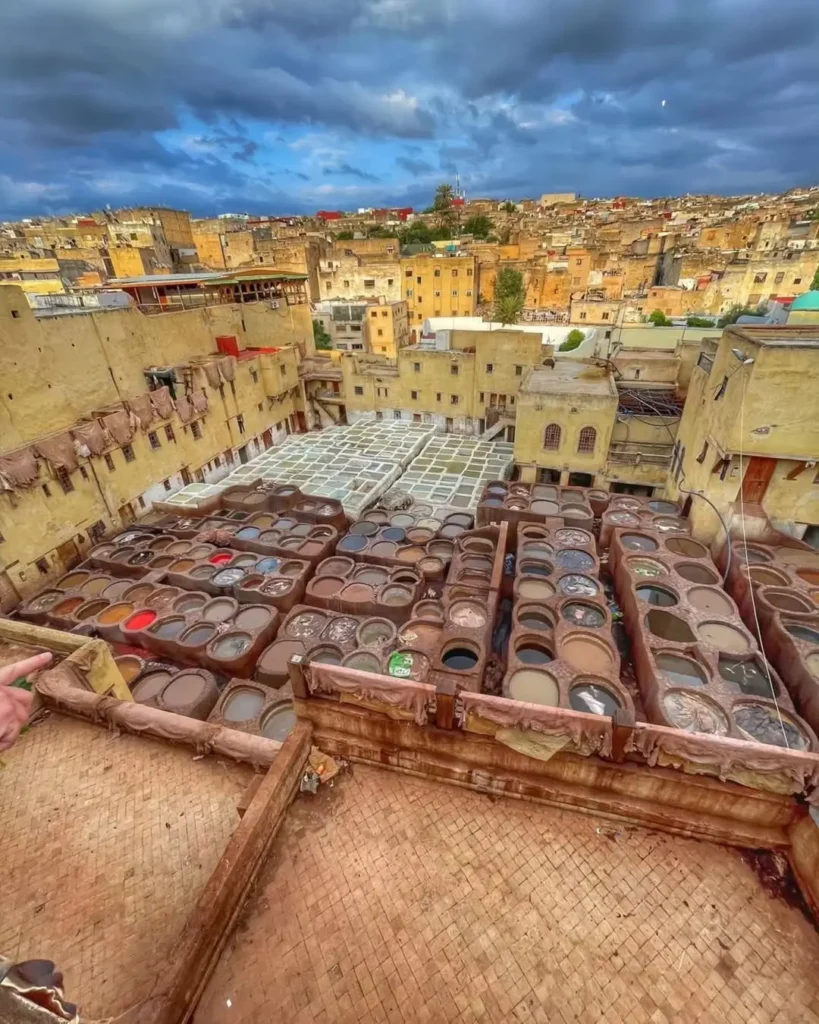

Stepping into the Fez el-Bali, the ancient walled medina of Fez, is like stepping back in time. Founded over 1,200 years ago, it’s one of the world’s largest living medieval cities, a UNESCO World Heritage site pulsating with life. Forget maps; navigating its thousands of narrow, winding alleyways is an adventure in itself. Your senses are immediately overloaded – the vibrant colours of textiles and leather goods, the rhythmic clang of artisans’ hammers, and, most importantly, the intoxicating aromas. Hints of exotic spices mingle with the scent of grilling meats, fragrant mint tea, and the sweet tang of preserved lemons, creating an olfactory map of the city’s culinary landscape.
Here, food isn’t just sustenance; it’s woven into the fabric of history and culture. Every dish tells a story, reflecting centuries of Berber, Arab, Moorish, and Mediterranean influences. To truly understand Moroccan cuisine, we need a guide, someone who knows these streets and their secrets intimately. Enter Fatima, a Fez native with a warm smile and an encyclopedic knowledge of local food traditions. “Welcome,” she says, “In Fez, we don’t just cook; we share our history on a plate. Let me show you.”
The Pillars of Moroccan Cuisine: Must-Try Dishes in Fez
Guided by Fatima, we embark on our quest to discover the quintessential traditional Moroccan dishes that form the foundation of this acclaimed cuisine.
Khobz: More Than Just Bread, It’s the “Moroccan Spoon”
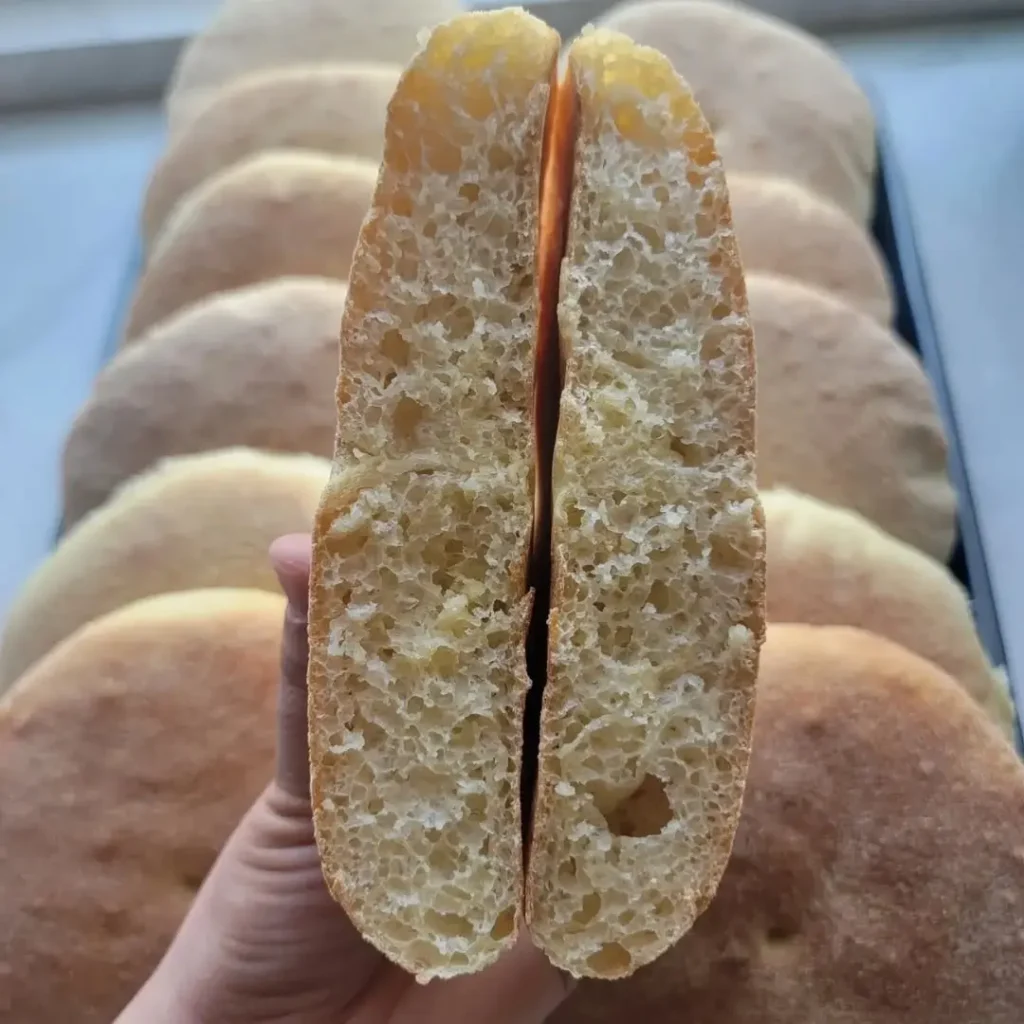
- The Foundation: No Moroccan meal is complete without Khobz. This round, often slightly flattened bread is ubiquitous, found on every table, in every home, and sold fresh from countless bakeries.
- Traditional Baking: Fatima leads us down a narrow lane to a hidden gem: a 17th-century communal wood-fired oven, known as a Farran. Here, families bring their kneaded dough to be baked. The air is thick with warmth and the incredible aroma of baking bread. The baker expertly slides loaves in and out using a long wooden peel.
- Simple Ingredients: The magic lies in its simplicity: typically just wheat flour (sometimes mixed with barley or semolina), yeast, salt, and water.
- Unique Flavor: What sets the Farran-baked Khobz apart is the distinct, subtly smoky flavour imparted by the cedar or olive wood used to fuel the oven. It’s warm, crusty on the outside, and soft within.
- Cultural Role: “We rarely use forks for tagine or dips,” Fatima explains, tearing off a piece of warm Khobz. “The bread is our spoon!” This communal aspect extends beyond the table; the Farran itself acts as a neighbourhood hub, fostering community spirit. It’s a cornerstone of daily life and a fundamental part of experiencing Moroccan Cuisine Fez.
Tagine: The Art of Slow Cooking in Clay
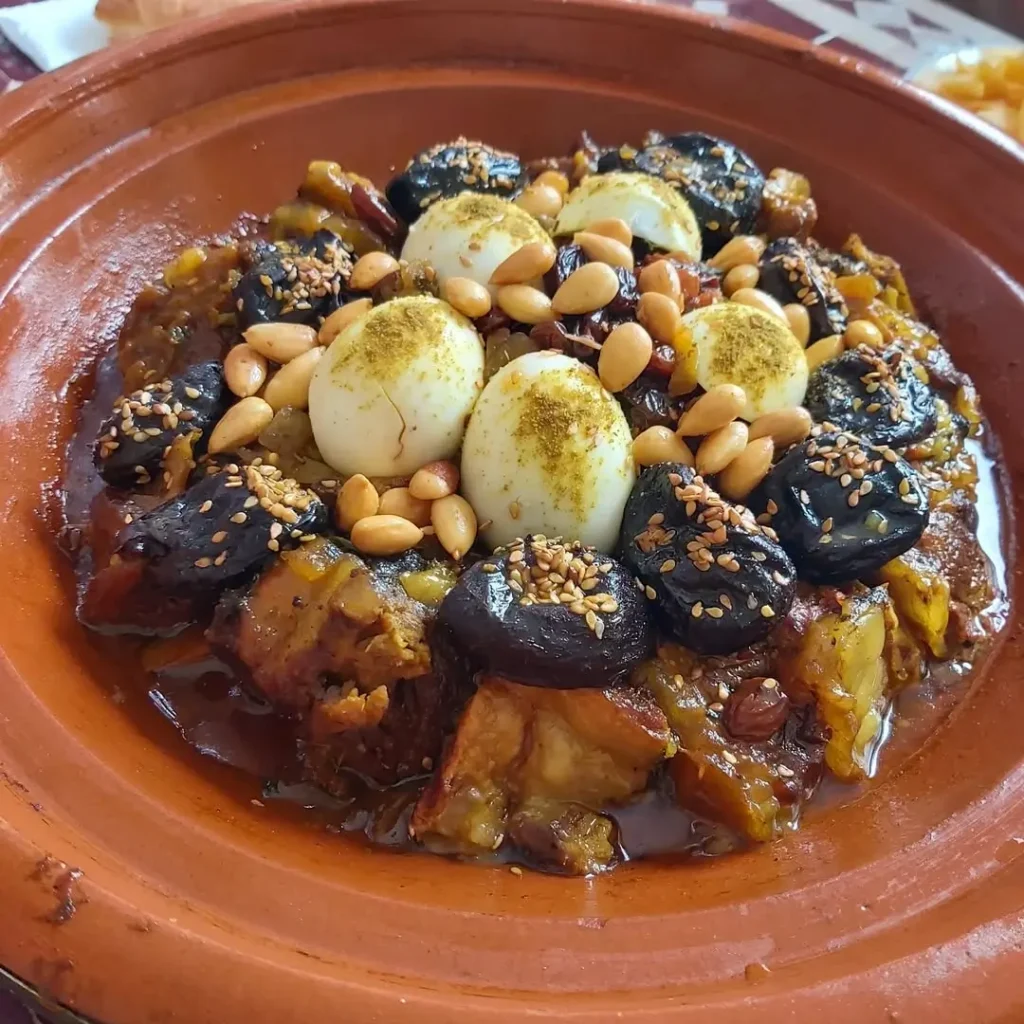
If one dish symbolizes Moroccan cuisine, it’s the Tagine. But the name refers to both the iconic cooking vessel and the stew itself.
- The Iconic Pot: The tagine pot, with its distinctive conical lid sitting atop a shallow base, is a marvel of culinary engineering.
- How the shape creates a self-basting environment: As the stew simmers, steam rises, hits the cooler cone, condenses, and drips back down onto the ingredients. This process keeps everything incredibly moist and tender without needing excess liquid.
- Perfect for slow-cooking meats to tender perfection: The heavy earthenware distributes heat evenly, allowing tough cuts of meat to slowly break down over low heat until they are melt-in-your-mouth tender.
- Flavor Profiles: The variety is endless, showcasing Morocco’s famous sweet and savory combinations:
- Savory Vegetable & Chicken Tagine: A classic featuring tender chicken, potatoes, carrots, zucchini, olives, and often preserved lemons, simmered in a fragrant broth infused with garlic, parsley, ginger, and turmeric.
- Complex Sweet & Savory Goat Tagine: A more adventurous profile might feature succulent goat meat slow-cooked with onions, saffron, ginger, and then sweetened with prunes, apricots, and toasted almonds or walnuts – a true explosion of flavour and texture.
- Ingredients: Common bases include beef, lamb, chicken, or goat, combined with a symphony of spices, onions, garlic, olive oil, and seasonal vegetables. The combinations are a testament to the depth of traditional Moroccan dishes.
Couscous: A Friday Feast of Fluffy Perfection
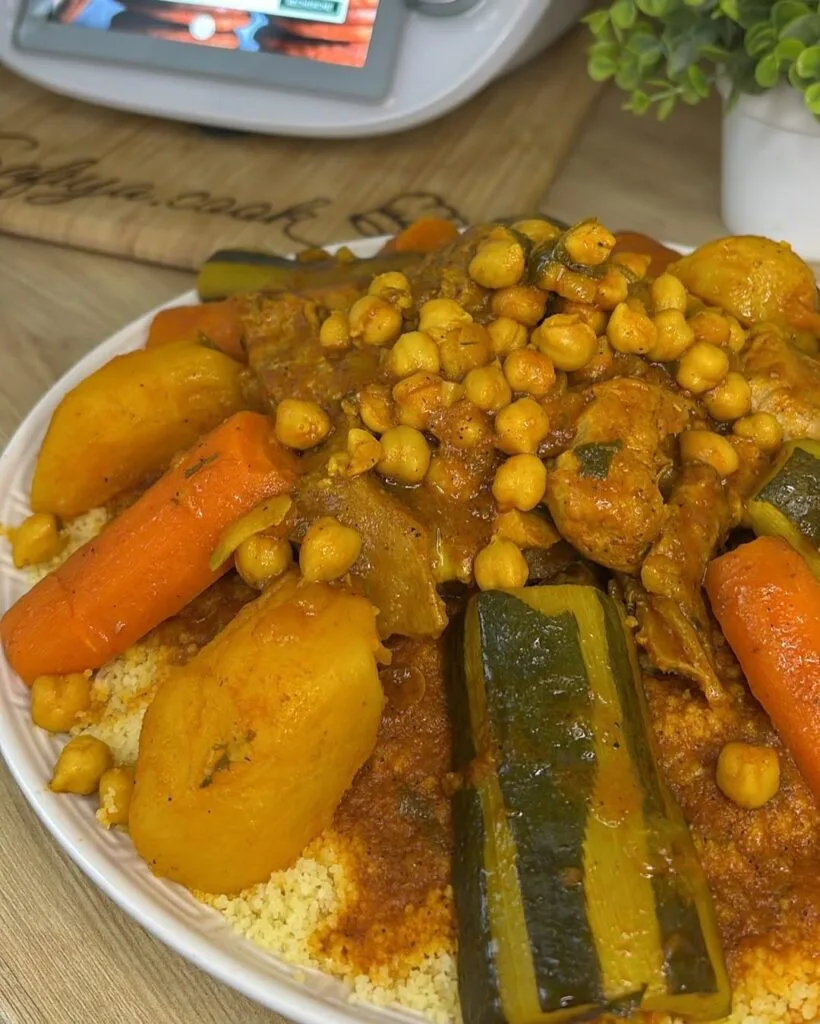
- Cultural Significance: While available daily for tourists, Couscous holds a special place in Moroccan hearts as the traditional Friday meal. After midday prayers, families gather to share a large, communal platter – a deeply ingrained ritual celebrating family and faith.
- The Process: Preparing authentic couscous is a labour of love, far removed from the instant varieties found elsewhere.
- Base: It starts with semolina (granules of durum wheat), lightly oiled and salted, then meticulously hand-rolled and steamed multiple times using a special pot called a couscoussier.
- Steamed over a flavorful stew: The top part of the couscoussier has holes, allowing the couscous grains to steam gently over a rich, simmering stew (often beef or lamb) packed with vegetables like cabbage, carrots, turnips, pumpkin, and eggplant in the bottom pot.
- Texture & Flavor: The result is incredibly light, fluffy individual grains that have absorbed the aromatic steam from the broth below. Couscous isn’t just a side dish; Fatima calls it a “flavor vehicle,” perfectly soaking up the delicious sauce and complementing the tender meat and vegetables. It’s a staple you must try when exploring what to eat in Fez.
Pastilla: The Surprising Sweet & Savory Pigeon Pie
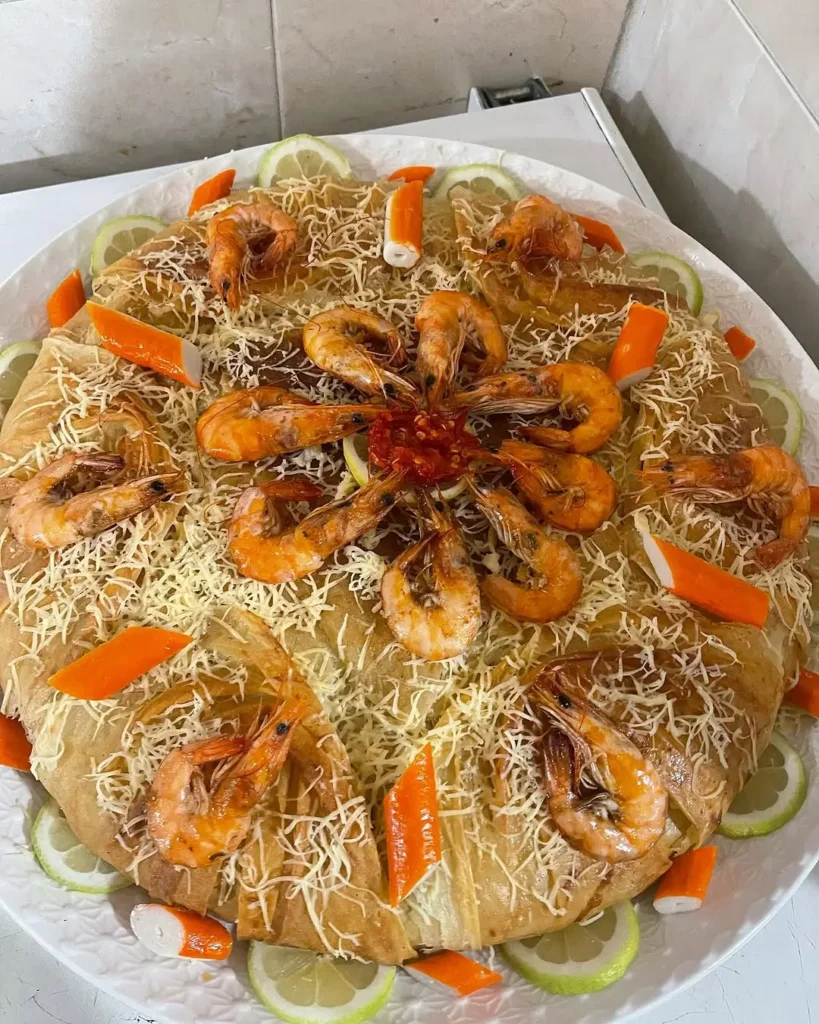
Prepare for a delightful culinary contradiction! Pastilla (also spelled B’stilla) looks like an elaborate dessert, often dusted with powdered sugar and cinnamon, but it’s traditionally a savory main course.
- An Identity Crisis: This dish beautifully encapsulates the unique flavour pairings found in the best Moroccan food.
- Key Ingredients:
- Traditionally uses young pigeon meat (tender): While chicken is now common, pigeon offers a richer, gamier flavour. The meat is slow-cooked and shredded.
- Layers of thin, crispy pastry (Warqa): Imagine ultra-thin, delicate layers similar to phyllo dough, creating a satisfying crunch.
- Complex filling: The spiced meat is mixed with onions, parsley, coriander, and often an almond layer, sometimes bound with a light egg mixture.
- Sweet toppings: The crispy dome is typically adorned with a lattice of cinnamon and powdered sugar, sometimes toasted almonds, honey, or even delicate rose petals.
- Flavor Profile: The experience is extraordinary: the crunch of the pastry gives way to the savory, spiced meat filling, followed by the surprising sweetness of the toppings. It’s a harmonious collision of sweet, savory, spiced, tender, and crispy – a true showstopper in Moroccan cuisine.
Chicken Rfissa: Gordon Ramsay’s Crown Jewel?
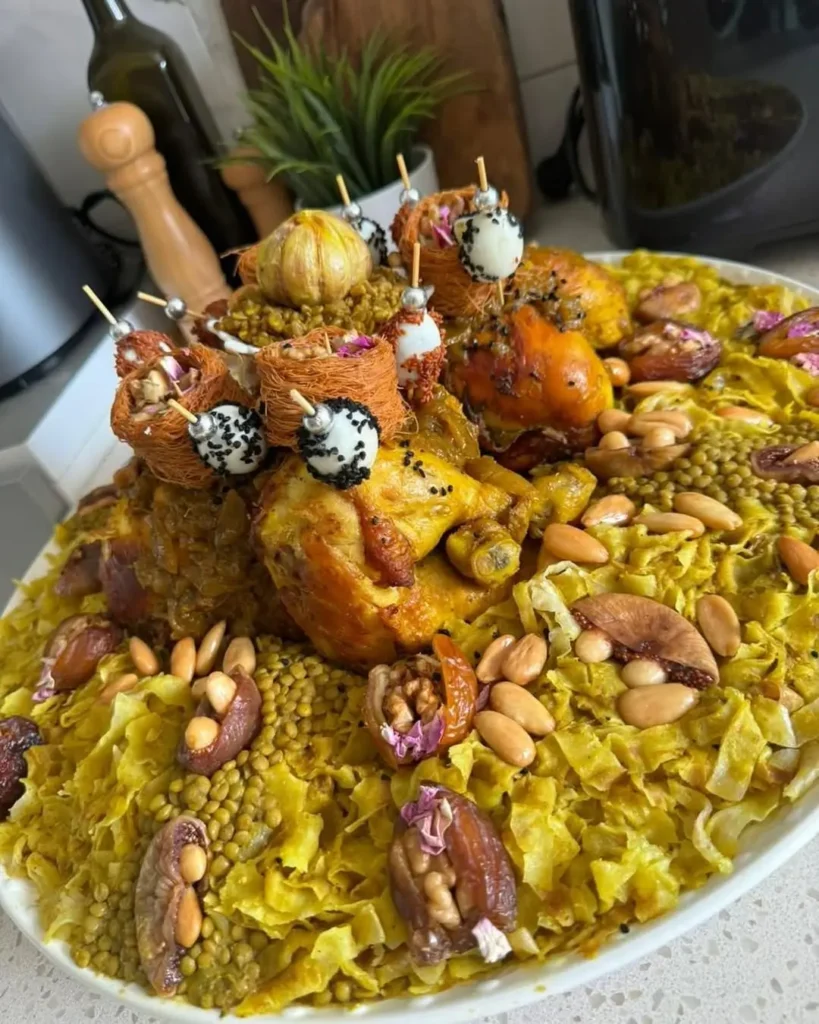
Rumour has it that this lesser-known, often home-cooked dish is one of Gordon Ramsay’s personal favourites from his Moroccan culinary explorations. Rfissa is hearty, comforting, and incredibly flavorful.
- Ramsay’s Alleged Favorite: While not as common in everyday restaurants as tagine or couscous, Rfissa is a treasured dish, often prepared for special occasions.
- Key Components:
- Marinated, tender chicken: Chicken is cooked until incredibly tender in a fragrant broth.
- Fragrant broth with lentils, fenugreek, ginger, turmeric, onions: The soul of Rfissa lies in its unique broth, strongly flavoured with helba (fenugreek seeds), which impart a distinct, slightly bitter, maple-syrup-like aroma, balanced with warming spices like ginger and turmeric, saffron (Ras el Hanout), and softened onions. Earthy lentils add substance.
- Served over shredded, layered flatbread (Msemen or Trid): Instead of couscous or rice, the base is shredded pieces of a flaky, layered Moroccan flatbread (Msemen) or a paper-thin crepe (Trid), which soak up the flavourful broth beautifully.
- Presentation: Often elaborately garnished with toasted almonds, dates, hard-boiled eggs, or dried apricots, making it a feast for the eyes as well as the palate.
- Occasion: Traditionally, Rfissa is served to new mothers (fenugreek is believed to aid lactation) or to honour special guests, signifying warmth and generosity. It represents the heart of home-style Moroccan cuisine.
Flavors Unveiled: The Magic of Moroccan Spices & Techniques
Our journey through these traditional Moroccan dishes reveals recurring themes. The most striking is the masterful “sweet & savory dance.” Caramelized onions, sweet spices like cinnamon, and dried fruits (prunes, apricots, raisins) are frequently paired with savory meats and earthy spices, creating complex layers of flavour unlike anywhere else.
The Moroccan spice palette is rich and aromatic. Key players include:
- Turmeric: Earthy flavour and vibrant yellow colour.
- Ginger: Pungent warmth.
- Cumin: Smoky and essential.
- Cinnamon: Used in both sweet and savory dishes.
- Saffron: Luxurious aroma and colour (used sparingly).
- Paprika: Sweet or smoked, for colour and flavour.
- Ras el Hanout: Literally “head of the shop,” a complex blend (sometimes 30+ spices) that varies by vendor, adding a unique signature warmth and depth.
Equally important are the traditional methods: the slow, moist cooking in tagine pots, the smoky kiss of the communal Farran, and the patient hand-preparation of couscous and warqa pastry. These techniques are integral to achieving the unique textures and deep flavours that define the best Moroccan food.
Beyond the Food: Moroccan Hospitality and Culture
Experiencing Moroccan cuisine is inseparable from experiencing Moroccan culture, particularly its legendary hospitality. Sharing food is paramount. Meals are often served communally, with everyone gathering around a large tagine or couscous platter, using Khobz to scoop up bites. This fosters a sense of connection and generosity.
Food marks significant life events and celebrations. Couscous on Fridays, Rfissa for new mothers or honoured guests, elaborate pastries and sweets for weddings and holidays – these culinary traditions reinforce social bonds and cultural identity. Being invited to share a meal is a genuine expression of welcome.
The Verdict: Is Moroccan Food Really #1?
After several days immersed in the culinary heart of Fez, guided by Fatima, tasting dishes prepared with ancient techniques and complex spice blends, what’s the verdict on Ramsay’s claim?
- Complexity & Depth: There’s no denying the incredible range, historical depth, and unique flavour profiles of Moroccan cuisine. From the simple perfection of wood-fired Khobz to the intricate layers of Pastilla and the comforting richness of Rfissa, it’s a cuisine that constantly surprises and delights. The balance of sweet and savory is truly masterful.
- Host’s Impression: I am deeply impressed. The flavours encountered in Fez were unlike anything I’d tasted before. The slow-cooking methods yield unparalleled tenderness, and the skillful use of spices creates aromatic and unforgettable dishes. The search for the best Moroccan food yielded incredible results.
- Subjectivity of “Best”: However, declaring any cuisine definitively “the best” in the world is inherently subjective. Food is personal, tied to memory and preference. While Moroccan cuisine is undoubtedly exceptional and a strong contender, crowning it #1 after exploring just one (albeit crucial) city feels premature. Perhaps more “research” (i.e., more eating across Morocco!) is needed.
What is certain is that Moroccan cuisine, especially experienced through the lens of Moroccan Cuisine Fez, offers a profound and delicious journey worth taking.
Your Turn to Explore Moroccan Flavors!
Feeling hungry after this virtual food tour of Fez? Inspired to explore the world of tagines, couscous, and pastilla?
- Pin It! Save this guide to your Pinterest board! Whether you’re planning a trip to Morocco or just want to try cooking some traditional Moroccan dishes at home, keep this inspiration handy.
- Share the Love! If you enjoyed this taste of Morocco, share this article with your friends on Facebook, Twitter, or your favorite social platform! Let them know why the best Moroccan food is something they need to experience.
- Comment Below! Have you tried Moroccan food? Did we miss your favorite dish? What’s your contender for the world’s best cuisine? Let us know your thoughts in the comments section!
Read: Top Europe Destinations
Frequently Asked Questions About Moroccan Food:
What are traditional Moroccan foods?
Traditional Moroccan foods include tagine (slow-cooked stew), couscous, pastilla (savory pie), harira (spiced soup), and a variety of grilled meats, seafood, and fresh salads. Moroccan cuisine is known for its rich flavors, aromatic spices, and unique combinations of sweet and savory ingredients.
What is the national dish of Morocco?
Couscous is the national dish of Morocco, typically served with vegetables, meat, and a flavorful broth. It is traditionally eaten on Fridays, the holy day in Islam, as a special family meal.
What is the Moroccan food menu?
A typical Moroccan menu includes appetizers like zaalouk (eggplant dip) and briouats (stuffed pastries), main dishes such as tagine and couscous, and desserts like chebakia (honey-coated pastries) and mint tea. Meals often feature bold spices like cumin, cinnamon, saffron, and preserved lemons.
What’s the best food to eat in Morocco?
Some of the best foods to try in Morocco include lamb or chicken tagine, seafood pastilla, slow-cooked mechoui (roast lamb), and fresh street foods like msemen (flaky pancakes) and sfenj (Moroccan doughnuts). Every region has its specialties, making Moroccan cuisine a diverse and flavorful experience.